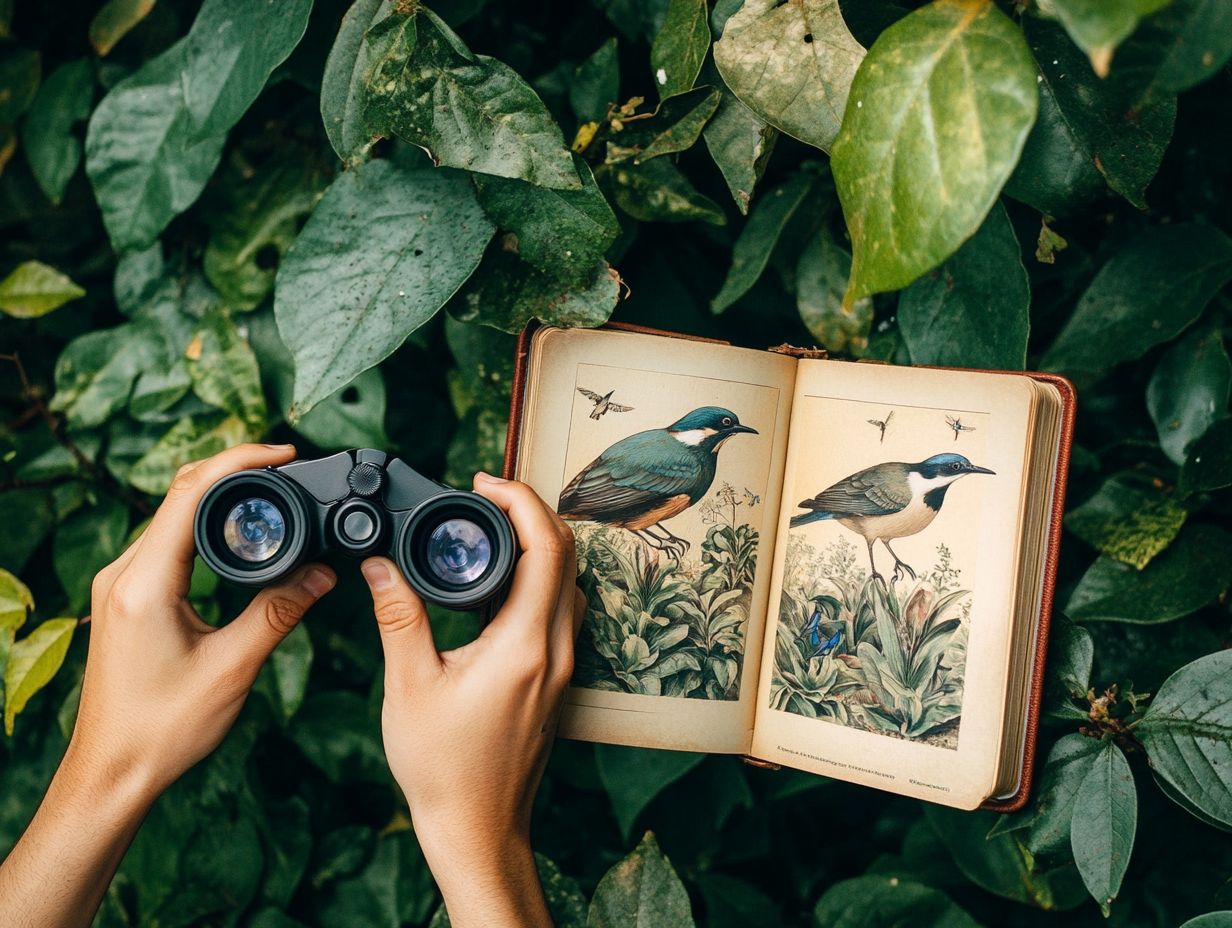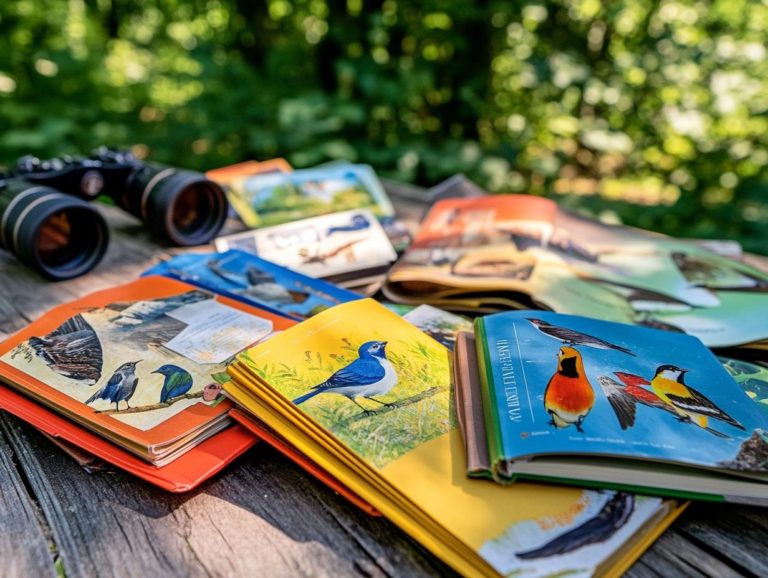Birdwatching Techniques Enhanced by Field Guides
Birdwatching is a delightful hobby that allows you to connect with nature. It offers a unique glimpse into the lives of our feathered friends and lets you observe birds in various environments.
Field guides are essential for all birdwatchers. They help you identify different bird species and understand their unique behaviors and calls.
Discover the exciting benefits of using field guides for your birdwatching adventures! This exploration covers the different types available, how to choose the perfect guide, and practical tips for effective birdwatching. We’ll also highlight common pitfalls to avoid, ensuring you make the most of your time outdoors in bird-friendly habitats.
Join us on this exciting journey to enhance your birdwatching skills and deepen your engagement with the birdwatching community!
Contents
Key Takeaways:

- Birdwatching is a popular recreational activity that involves observing and identifying birds, including backyard birds, in their natural habitats.
- Field guides are essential tools for birdwatchers, providing information on bird species, behaviors, and habitats to enhance your birding experience.
- When choosing a field guide, consider the format, level of detail, and portability to ensure it meets your specific needs for effective birdwatching in various locations.
What is Birdwatching?
Birdwatching, or birding as it s often called, is a delightful outdoor pursuit that invites you to observe birds in their natural habitats. Whether you’re in the heart of a bustling city or wandering through tranquil nature preserves, this activity offers a chance to engage deeply using everything from binoculars to birding apps. You can identify various species and study their fascinating behaviors and calls.
This immersive experience not only enhances your appreciation for nature but also nurtures a sense of community among fellow birdwatchers. The roots of birdwatching stretch back to the 19th century when naturalists began documenting bird life, laying the groundwork for today’s rich appreciation.
As you delve into this hobby, you might find yourself employing techniques such as photography, note-taking, and joining guided walks to deepen your understanding. Local Audubon societies, like the Georgia Audubon, play a crucial role in this journey, organizing community outings and birding festivals while championing conservation efforts to protect vital habitats.
From national parks to urban wetlands, popular birding locations abound, each offering a unique array of species for you to track. This pastime not only connects you to the wonders of nature but also contributes significantly to raising awareness for wildlife protection, harmonizing your personal enjoyment with broader conservation goals and fostering bird-friendly habitats.
Benefits of Using Field Guides
Utilizing field guides is crucial for birdwatchers at any skill level. These tools offer invaluable insights for identifying birds and elevating your overall birding experience.
These resources include detailed descriptions of a wide range of bird species, their calls, and behaviors, helping you recognize and appreciate the nuances of different birds, including backyard birds, in their natural habitats.
How Field Guides Enhance Birdwatching
Field guides elevate your birdwatching experience by offering essential tools for bird identification. They provide you with the knowledge to recognize various species and explore their behaviors, calls, and habitats, highlighting the importance of field guides in bird watching.
With vivid illustrations and detailed descriptions, these guides become essential companions, whether you’re a novice or a seasoned birdwatcher. For those looking to enhance their experience, exploring field guide features that make birdwatching easier can provide visual aids to help you distinguish between similar species, while comprehensive notes on each bird’s characteristics such as size, coloration, and markings boost your identification accuracy.
Many guides also delve into bird behaviors and habitats, enriching your understanding of when and where to observe specific birds, including their migration patterns. Exploring field guides: the art of birdwatching simplified sharpens your identification skills and fosters a deeper appreciation for the intricate lives of birds, making your outdoor excursions more rewarding and enjoyable.
Types of Field Guides
Field guides come in a variety of formats, primarily as printed and electronic versions, such as birding apps. Each format presents distinct advantages for the discerning birdwatcher.
Printed guides provide a hands-on experience. Their beautiful illustrations make them enjoyable to browse and easy to carry on your birdwatching trips.
On the other hand, electronic guides enhance your experience with the convenience of accessibility via specialized birding apps and websites, like eBird and Merlin Bird ID. This ensures that information is always at your fingertips.
Printed Guides

Printed guides are helpful tools for birdwatchers, as they offer detailed illustrations and descriptions of various bird species. For a deeper understanding of how these resources can enhance your experience, check out field guides, making identification in the field a breeze.
These guides truly shine, especially when technology is out of reach! With their well-organized layouts often categorized by habitat, season, or family they allow for quick references, ensuring they re user-friendly no matter where you find yourself, from lush wetlands to serene wooded areas.
The captivating illustrations often showcase unique markings and behaviors, making it easier to differentiate between similar species. Renowned printed guides, like the Sibley Guide and resources from the Cornell Lab of Ornithology, have made a significant impact on the birdwatching community.
They provide a rich collection of species illustrations and in-depth information, enhancing your overall experience of identifying and appreciating the wonders of avian life.
Electronic Guides
Electronic guides, including various birding apps, have transformed how you engage with your birdwatching hobby. They offer instant access to information on bird species, calls, and behaviors.
Apps like eBird and Merlin Bird ID elevate your birding experience with their user-friendly interfaces and interactive features. These platforms help you quickly identify birds and enable you to contribute to citizen science by sharing your sightings. This means you can help scientists track bird populations by sharing what you see.
Real-time updates keep you in the loop about migratory patterns and local bird activity, ensuring that each outing is more productive. For example, the Audubon Bird Guide app provides a comprehensive field guide along with a tracking feature to help you log your findings and record your bird journals.
The community aspect is further enhanced with social sharing options. These allow you to discuss sightings and tips with fellow birding enthusiasts, fostering a deeper connection among aficionados. This blend of accessibility and interactive engagement truly redefines modern birdwatching for you.
How to Choose the Right Field Guide
Choosing the right field guide is a pivotal step for any birdwatcher. It profoundly influences not only the accuracy of bird identification but also the overall enjoyment of your birding adventures. To enhance your experience, learn how to use a field guide for bird watching.
Consider factors such as your location, the species you re hoping to spot, and your personal preferences to uncover the guide that best suits your needs, including local Audubon recommendations.
Factors to Consider
When choosing a field guide, it s essential to weigh several factors to ensure it aligns with your needs. Consider the geographic area it covers, the level of detail in its illustrations, and whether it offers additional resources like birdwatching tips or identification techniques.
Think about the target audience for the guide. Some are tailored specifically for beginners with simplified information, while others dive deeper for those with more experience, including advanced bird identification techniques.
A guide that includes visual aids, like range maps and seasonal variations, can elevate your birdwatching experience. It helps you grasp migration patterns and habitat preferences of various bird species, especially when understanding bird identification with field guides.
Look for guides that highlight local birdwatching hotspots or community resources. These can enhance your birdwatching experiences and foster connections within the birdwatching community, encouraging collaboration and sharing experiences that deepen your understanding and appreciation of avian life.
Using Field Guides in the Field
Utilizing field guides during your birdwatching excursions can significantly elevate your experience. They enable you to identify bird species with precision and gain insights into their behaviors, including their sounds.
Honing your birdwatching skills and applying refined techniques is crucial. Adhering to proper birdwatching etiquette and engaging in bird photography will make your outings not only successful but also deeply enriching.
Tips and Techniques for Effective Birdwatching

To truly elevate your birdwatching experience, employing specific techniques and tips can enhance your chances of observing a diverse array of birds.
Consider the best birding hours, understand bird behavior, and make the most of birding accessories like binoculars and field guides.
Choosing the right location is essential. Visiting areas renowned for bird activity like wetlands, forests, or coastal regions can greatly enrich your experience and uncover hidden hotspots.
Remember to grab your quality binoculars and a reliable field guide; these items will allow for better identification and closer observations of bird behavior!
Timing your outings for early morning or late afternoon often yields the best results, as these are peak activity times for birds.
Lastly, patience and quiet can transform your adventure, allowing for a more immersive and rewarding birdwatching experience.
Common Mistakes to Avoid
While birdwatching is both an enjoyable and educational pursuit, it’s essential to steer clear of common mistakes. These can enhance your experience and show respect for nature.
Common pitfalls may include improper bird identification techniques and a disregard for birdwatching etiquette. By being mindful, you can elevate your birdwatching endeavors to new heights.
Pitfalls to Watch Out For
Understanding the pitfalls of birdwatching is crucial, whether you’re just starting out or have years of experience. This knowledge ensures a respectful and rewarding experience.
- Ignoring birding etiquette
- Leaning too heavily on technology
- Neglecting local wildlife regulations
Maintaining a respectful distance from nesting sites is often overlooked, yet it’s essential to protect delicate ecosystems. Avoid crowding or making loud noises, as these can easily scare birds away.
Over-reliance on apps and gadgets can rob you of the pure joy of experiencing nature directly. If you re overly dependent on technology, you might miss the subtle cues that only live observation can offer.
To navigate these challenges, consider tapping into credible resources like local birding clubs or established birdwatching guides. They can provide invaluable insights and deepen your appreciation for avian life.
Have you ever wondered why early mornings are the best for birdwatching? Get outdoors, grab your field guide, and start your birdwatching adventure today!
Summary and Final Thoughts
Birdwatching offers a unique experience that connects you to nature and builds a vibrant community. By using effective birding techniques, top-notch field guides, and good birdwatching manners, you can greatly enhance your enjoyment and understanding of the avian world.
This fascinating activity introduces you to many species and deepens your appreciation for local habitats. Whether you re thrilled by spotting a rare bird or enjoying the simple joy of backyard species, every moment is a chance for learning and discovery.
Connecting with fellow birders builds friendships and allows you to share tips that can make each outing more rewarding. By joining local birdwatching groups, accessing online forums, or attending workshops, you can expand your knowledge and enjoyment of this wonderful hobby.
Getting involved in the birdwatching community and tapping into available resources will make your experience even more rewarding for you and everyone around you.
Frequently Asked Questions
What is birdwatching?

Birdwatching is the fun activity of observing and identifying birds in their natural habitats.
How can field guides enhance birdwatching techniques?
Field guides are books or apps that provide information on identifying and understanding different bird species. They help birdwatchers improve their skills and knowledge.
What types of information can be found in field guides?
Field guides usually include details about a bird’s appearance, behavior, habitat, range, and calls. They also have illustrations, photos, and maps to help with identification.
Are there different types of field guides available?
Yes, there are many types, including regional guides, specialty guides for certain birds, and digital versions. Each one has unique features, so choose one that suits your birdwatching needs.
Do I need to be an expert to use a field guide?
No, field guides are made for everyone. They offer easy-to-understand information that s great for beginners wanting to learn about different bird species.
How can I use field guides effectively while birdwatching?
To use a field guide effectively, get familiar with it before you head out. Know its layout and features. While birdwatching, refer to field guides for building your birdwatching knowledge to identify birds by observing their characteristics and behavior.






